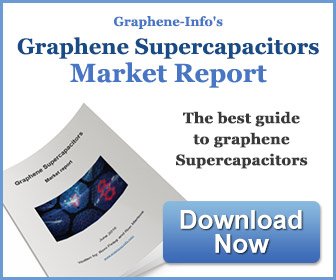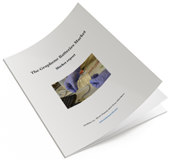Graphene supercapacitors
Graphene is a thin layer of pure carbon, tightly packed and bonded together in a hexagonal honeycomb lattice. It is widely regarded as a âwonder materialâ because it is endowed with an abundance of astonishing traits: it is the thinnest compound known to man at one atom thick, as well as the best known conductor. It also has amazing strength and light absorption traits and is even considered ecologically friendly and sustainable as carbon is widespread in nature and part of the human body.
Graphene is often suggested as a replacement for activated carbon in supercapacitors, in part due to its high relative surface area (which is even more substantial than that of activated carbon). The surface area is one of the limitations of capacitance and a higher surface area means a better electrostatic charge storage. In addition, graphene based supercapacitors will utilize its lightweight nature, elastic properties and mechanical strength.
A Graphene supercapacitor is said to store almost as much energy as alithium-ion battery, charge and discharge in seconds and maintain all this over tens of thousands of charging cycles. One of the ways to achieve this is by using a a highly porous form of graphene with a large internal surface area (made by packing graphene powder into a coin-shaped cell and then dry and press it).
What are supercapacitors?
Supercapacitors, also known as EDLC (electric double-layer capacitor) or Ultracapacitors, differ from regular capacitors in that they can store tremendous amounts of energy.
A basic capacitor usually consists of two metal plates, separated by an insulator (like air or a plastic film). During charging, electrons accumulate on one conductor and depart from the other. One side gains a negative charge while the other side builds a positive one. The insulator disturbs the natural pull of the negative charge towards the positive one, and that tension creates an electric field. Once electrons are given a path to the other side, discharge occurs.
Supercapacitors also contain two metal plates, only coated with a porous material known as activated carbon. They are immersed in an electrolyte made of positive and negative ions dissolved in a solvent. One plate is positive and the other is negative. During charging, ions from the electrolyte accumulate on the surface of each carbon-coated plate. Supercapacitors also store energy in an electric field that is formed between two oppositely charged particles, only they have the electrolyte in which an equal number of positive and negative ions is uniformly dispersed. Thus, during charging, each electrode ends up having two layers of charge coating (electric double-layer).
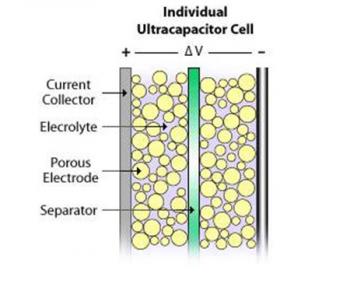
Batteries and Supercapacitors
Unlike capacitors and supercapacitors, batteries store energy in a chemical reaction. This way, ions are inserted into the atomic structure of an electrode, instead of just clinging to it like in supercapacitors. This makes supercapacitors (and storing energy without chemical reactions in general) able to charge and discharge much faster than batteries. Due to the fact that a supercapacitor does not suffer the same wear and tear as a chemical reaction based battery, it can survive hundreds of thousands more charge and discharge cycles.
Supercapacitors boast a high energy storage capacity compared to regular capacitors, but they still lag behind batteries in that area. Supercapacitors are also usually more expensive per unit than batteries. Technically, it is possible to replace the battery of a cell phone with a supercapacitor, and it will charge much faster. Alas, it will not stay charged for long. Supercapacitors are very effective, however, at accepting or delivering a sudden surge of energy, which makes them a fitting partner for batteries. Primary energy sources such as internal combustion engines, fuel cells and batteries work well as a continuous source of low power, but cannot efficiently handle peak power demands or recapture energy because they discharge and recharge slowly. Supercapacitors deliver quick bursts of energy during peak power demands and then quickly store energy and capture excess power that's otherwise lost. In the example of an electric car, a supercapacitor can provide needed power for acceleration, while a battery provides range and recharges the supercapacitor between surges.
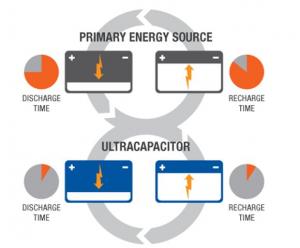
Common supercapacitor applications
Supercapacitors are currently used to harvest power from regenerative braking systems and release power to help hybrid buses accelerate, provide cranking power and voltage stabilization in start/stop systems, backup and peak power for automotive applications, assist in train acceleration, open aircraft doors in the event of power failures, help increase reliability and stability of the energy grid of blade pitch systems, capture energy and provide burst power to assist in lifting operations, provide energy to data centers between power failures and initiation of backup power systems, such as diesel generators or fuel cells and provide energy storage for firming the output of renewable installations and increasing grid stability.
Rivaling materials
Several materials exist that are researched and suggested to augment supercapacitors as much (or even more than) graphene. Among these materials are: hemp, that was used by Canadian researchers to develop hemp fibers that are at least as efficient as graphene ones in supercapacitor electrodes, Cigarette filters, which were used by Korean researchers to prepare a material for supercapacitor electrodes that exhibits a better rate capability and higher specific capacitance than conventional activated carbon and even higher than N-doped graphene or N-doped CNT electrodes.
Graphene supercapacitors commercialization
Graphene supercapacitors are already on the market, and several companies, including Skeleton Technology, the CRRC, ZapGoCharger, and Angstron Materials are developing such solutions. Read our Graphene Supercapacitors market report to learn more about this exciting market and how graphene will effect it.
Further reading
The latest graphene supercapacitor news:
Zero Emissions Developments seeks funding to establish graphene-based solar battery manufacturing plant
Zero Emissions Developments (ZED) is an Australia-based company that has announced the development of a technology to build longer lasting, greener, more efficient and more affordable graphene-based solar and EV batteries. It is now seeking AUD$30 million (around USD$22,300,000) in private investment to build a manufacturing plant that will produce these batteries.
The planned manufacturing plant will produce the PowerCap batteries in southeast Queensland through the entity, PowerCap Un Ltd.
Graphene-Info updates all its graphene market report
Today we published new versions of all our graphene market reports. Graphene-Info provides comprehensive niche graphene market reports, and our reports cover everything you need to know about these niche markets. The reports are now updated to April 2022.
The Graphene Batteries Market Report:
- The advantages using graphene batteries
- The different ways graphene can be used in batteries
- Various types of graphene materials
- What's on the market today
- Detailed specifications of some graphene-enhanced anode material
- Personal contact details into most graphene developers
The report package provides a good introduction to the graphene battery - present and future. It includes a list of all graphene companies involved with batteries and gives detailed specifications of some graphene-enhanced anode materials and contact details into most graphene developers. Read more here!
European grant to enable the development of supercapacitors based on nitrogen-doped graphene
Researchers from CATRIN at Palacký University Olomouc, in cooperation with colleagues from Bar-Ilan University in Israel and the Italian company ITELCOND, are working to develop high-capacity, safe, and environmental friendly supercapacitors based on a graphene-derived material developed in Olomouc, which is already protected by a European patent.
The work needed in order to translate this discovery into practice is made possible thanks to a grant funded by the European Innovation Council (EIC) Transition Challenges with an allocated budget of nearly 2.5 million Euros.
Ionic Industries acquires Imagine Intelligent Materials
Ionic Industries has announced the conclusion of a takeover of Imagine Intelligent Materials, including plant and equipment, IP and commercial relationships.
With this acquisition, Ionic intends to become a major Australian graphene player, with a portfolio of advanced nano-technologies covering energy storage and sensing applications. Ionic has paid approximately AUD$600k (around USD$434,000) cash and 30 million Ionic shares.
Avadain receives $3.77 million grant to upscale its graphene flakes tech to mass production
U.S-based graphene flakes producer Avadain has announced that it will upscale its environmentally friendly process to mass production as part of a two-year project funded by a $3.77 million grant from the U.S. Department of Commerce’s National Institute for Standards and Technology (NIST).
We are excited to unleash the Graphene Revolution by making large, thin and nearly defect free graphene flakes available in industrial volumes and acceptable cost, says Bradley Larschan, CEO of Avadain.
ENA teams up with Jolta Battery to work on graphene supercapacitors for the Pakistani market
Pakistani startup Energy and Automation (ENA) recently joined forces with Jolta Battery, a sister company of Jolta Electric Pakistan’s First EV company, in an exclusive agreement to work on graphene-based Supercapacitors with an innovative power backup storage technology called ENARGEZE SUPERPOWER which is powered by Zoxcell.
ENA’s Chief Executive, Amir Salman, explained that the Supercapacitor is 25 times better than VRLA dry batteries. He said that this new technology is safe to use and minimizes the use of generators. In the bigger picture, this will contribute to a greener Pakistan by reducing carbon footprint and fuel consumption.
Researchers enhance the energy storage capacity of graphene supercapacitors via solar heating
Researchers from the Chinese Academy of Sciences (CAS), the University of Science and Technology of China and Tianjin University have enhanced the energy storage capacity of graphene supercapacitors via solar heating.
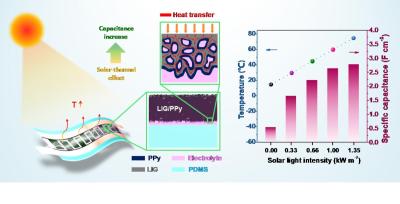
In low temperature environments, the hindered diffusion of electrolyte ions can restrict the electrochemical performance of supercapacitors. Electrode materials with solar-thermal properties are expected to provide a new strategy to solve this problem. However, it remains a challenge to develop electrode materials with both excellent solar-thermal properties and high energy storage capacity.
Skeleton Technologies closes €37.6 million D3 financing round
Skeleton Technologies has announced its Round D3 with 37.6 million euros of equity investments. The Round was led by Taavet Hinrikus, from Taavet+Sten with Nidoco AB, EIT Innoenergy, Bengt Wahlqvist, co-founder of battery charging specialist CTEK, a group of founding team members of Adyen and others joining.
The investments will be aimed at further scale-up of supercapacitor production in Saxony, Germany, to meet customer demand and continuing the development of supercapacitor and curved graphene technology in new battery products.
Graphene-Info updates all its graphene market report
Today we published new versions of all our graphene market reports. Graphene-Info provides comprehensive niche graphene market reports, and our reports cover everything you need to know about these niche markets. The reports are now updated to January 2022.
The Graphene Batteries Market Report:
- The advantages using graphene batteries
- The different ways graphene can be used in batteries
- Various types of graphene materials
- What's on the market today
- Detailed specifications of some graphene-enhanced anode material
- Personal contact details into most graphene developers
The report package provides a good introduction to the graphene battery - present and future. It includes a list of all graphene companies involved with batteries and gives detailed specifications of some graphene-enhanced anode materials and contact details into most graphene developers. Read more here!
First Graphene secures Innovate UK funding for supercapacitor research
Last month, First Graphene (FGR) announced a milestone in its program to develop high performing supercapacitor materials. Now, the Company announced it has been awarded funding from Innovate UK EDGE to progress development work on its supercapacitor graphene hybrid materials with a Research and Technology Organization (RTO) based in the United Kingdom.
The Innovate EDGE fund supports high-growth small to medium enterprises (SMEs) to scale up and innovate, working alongside the UK’s RTO and Catapult Network. The Company will engage with world-leading experts at the Energy Innovation Centre based at Warwick Manufacturing Group (WMG) part of the Catapult Network.
Pagination
- Previous page
- Page 4
- Next page
